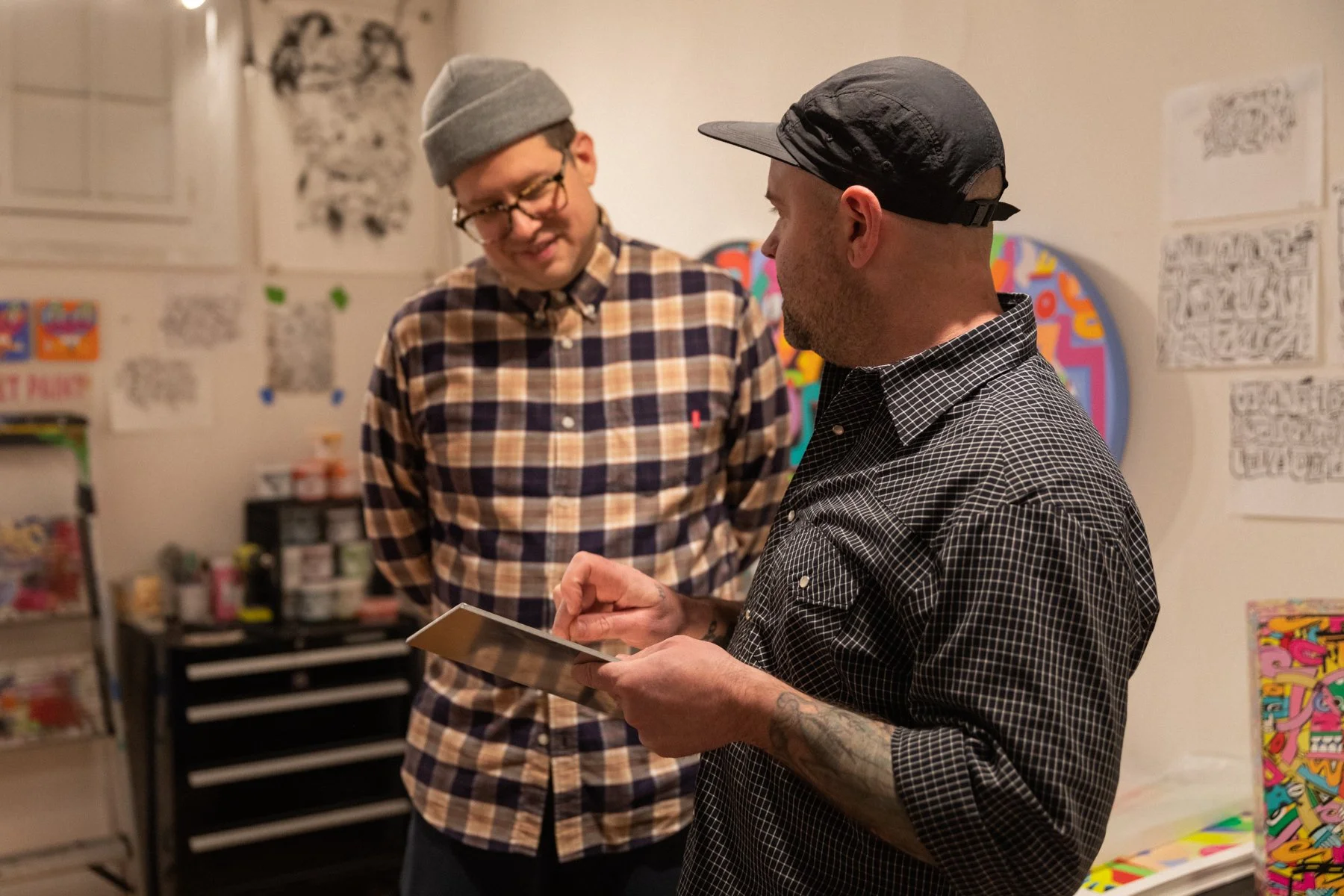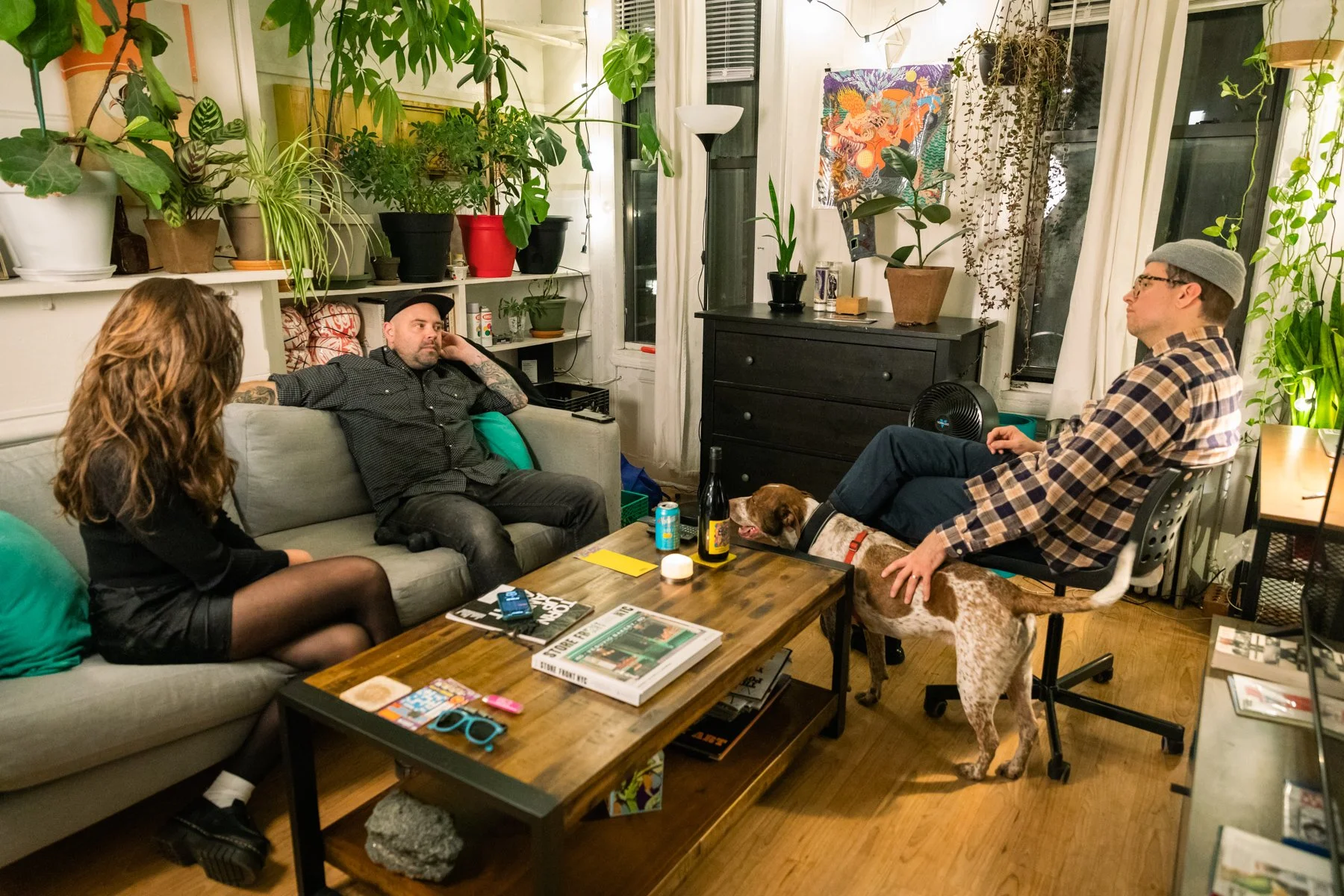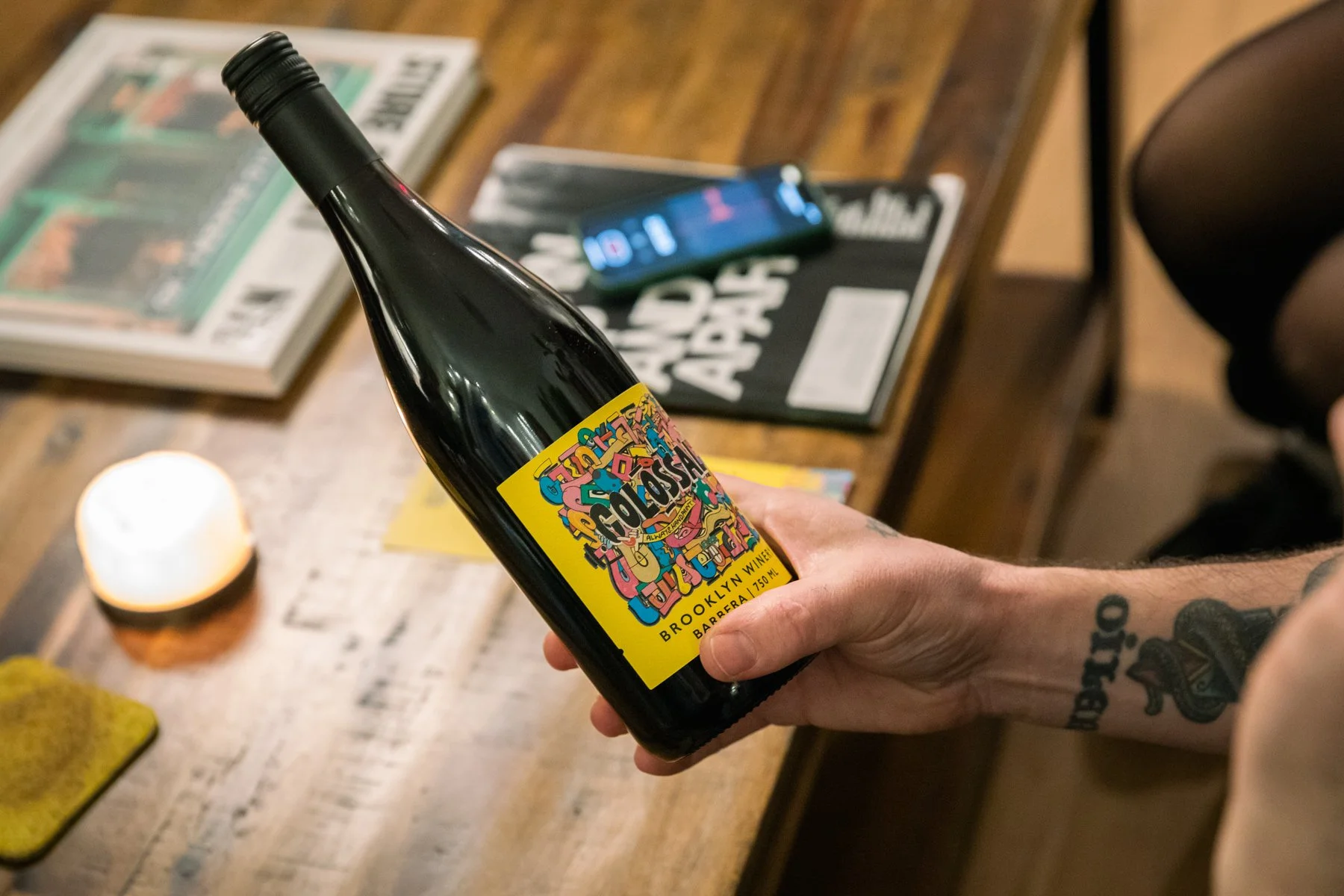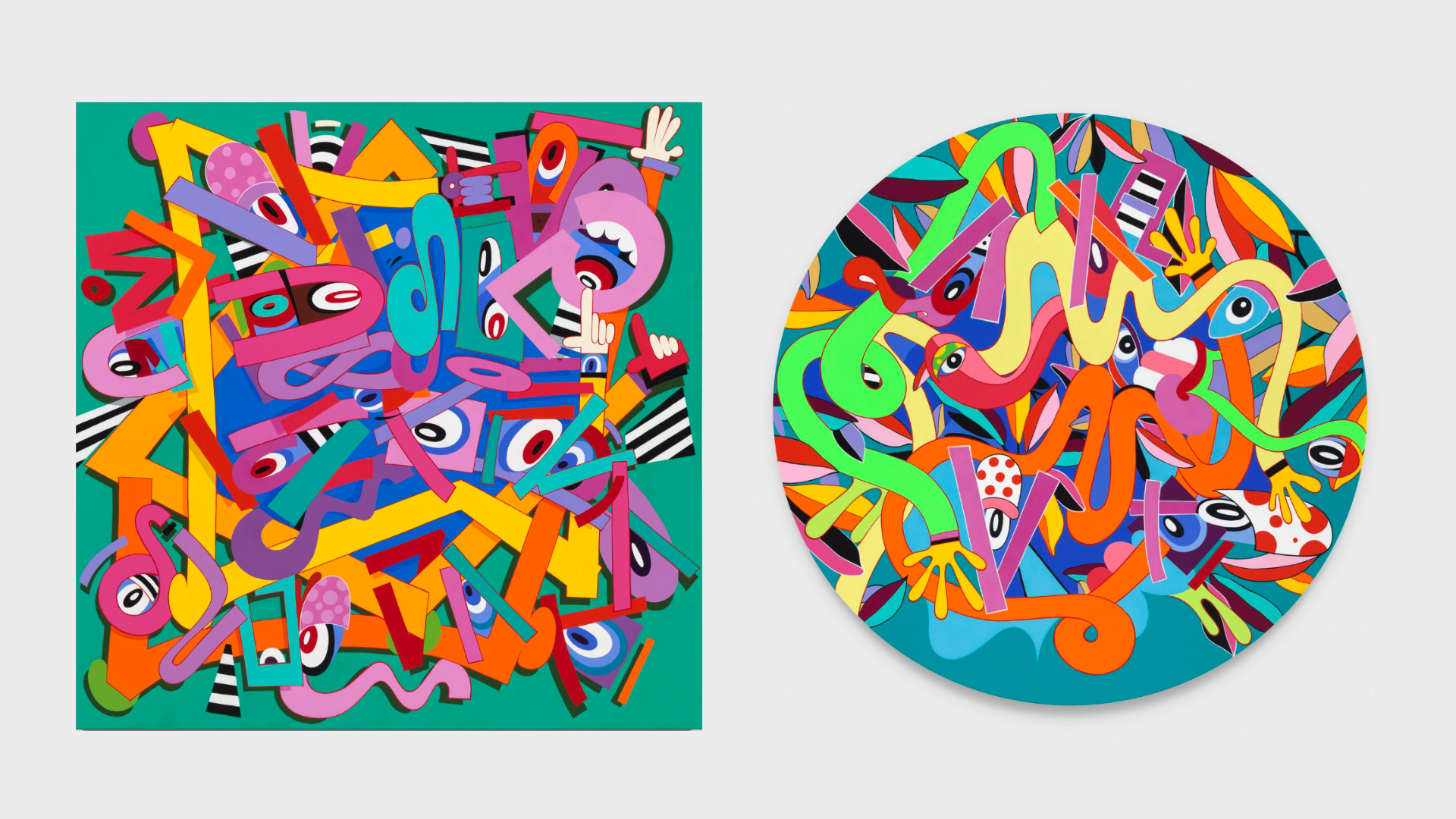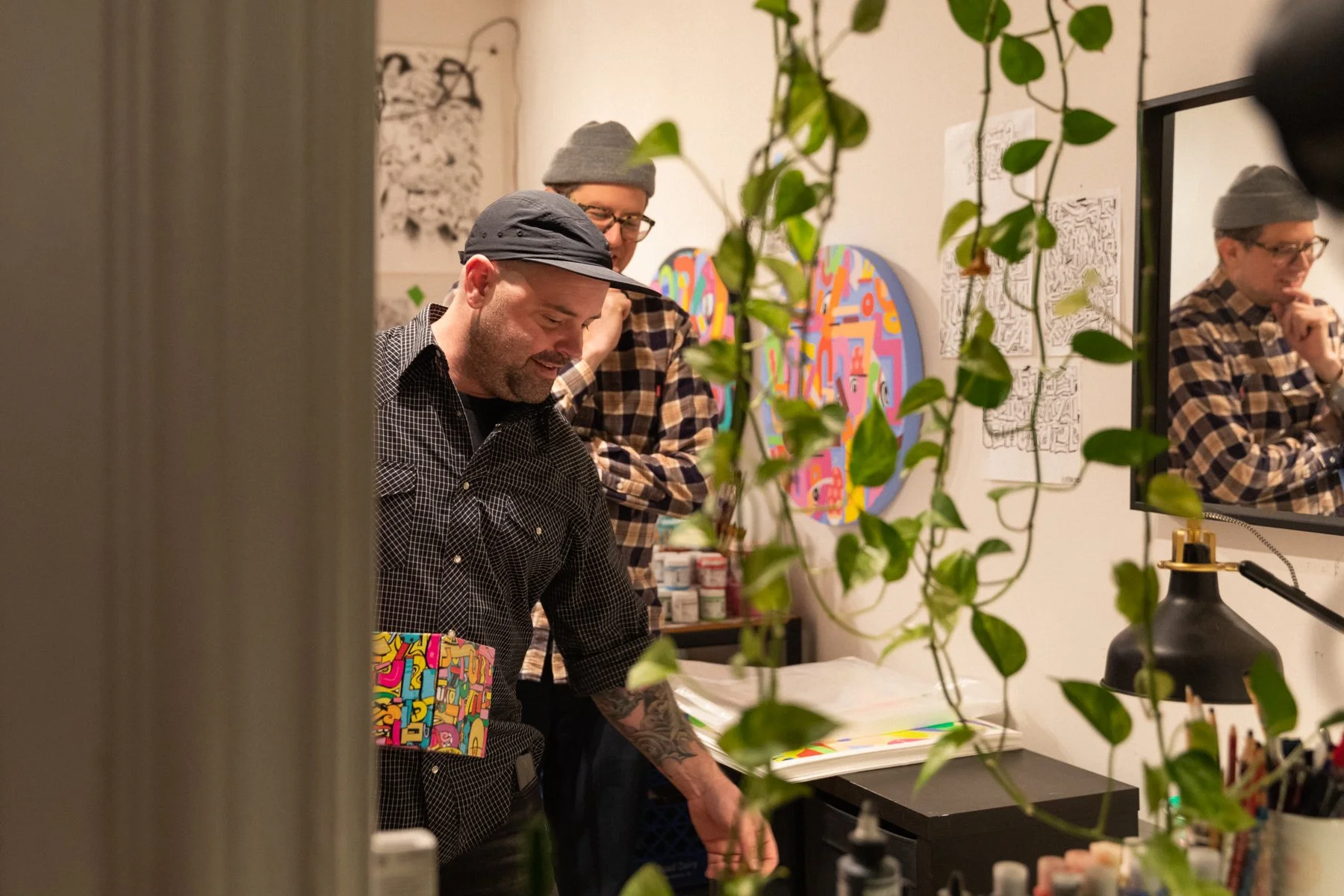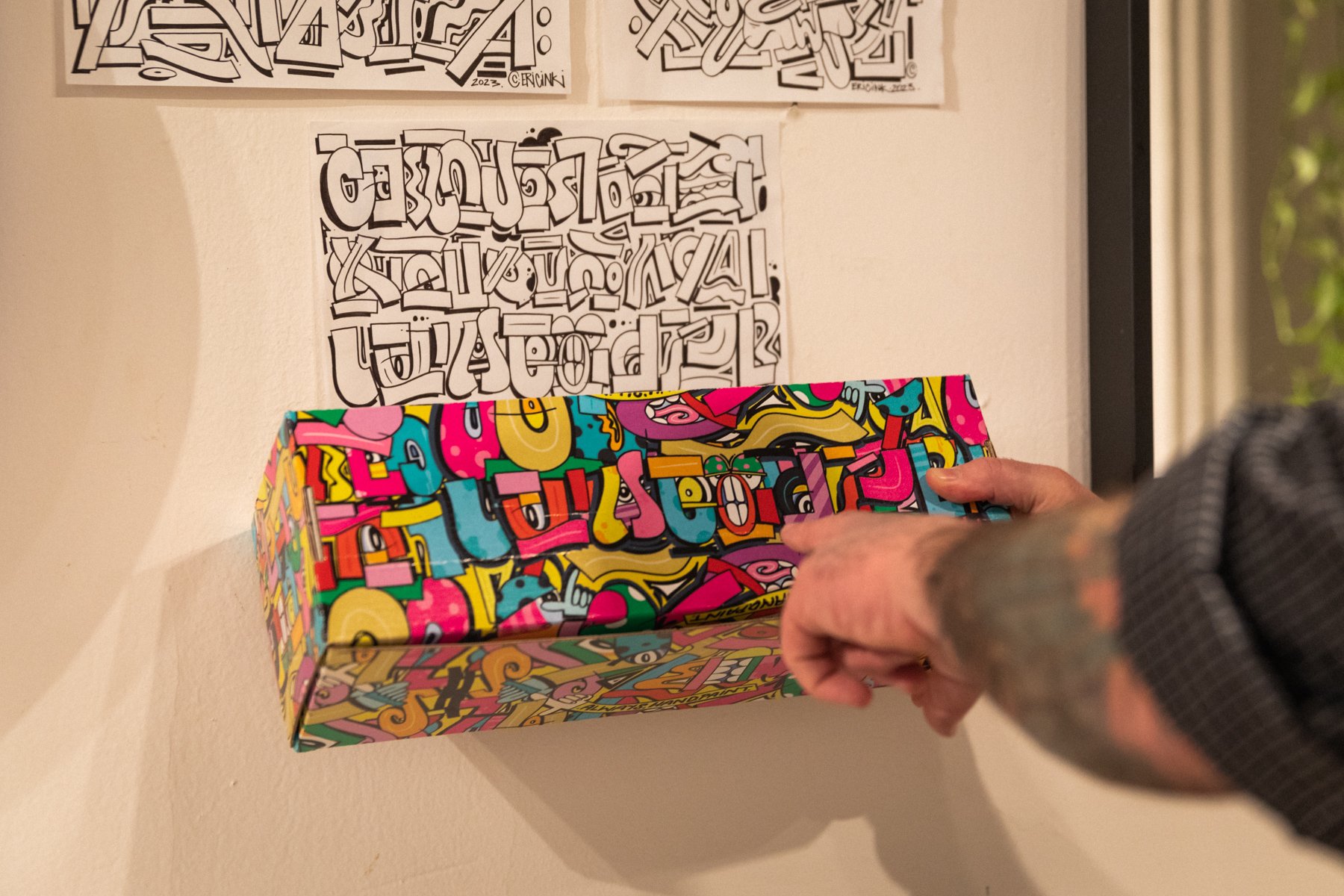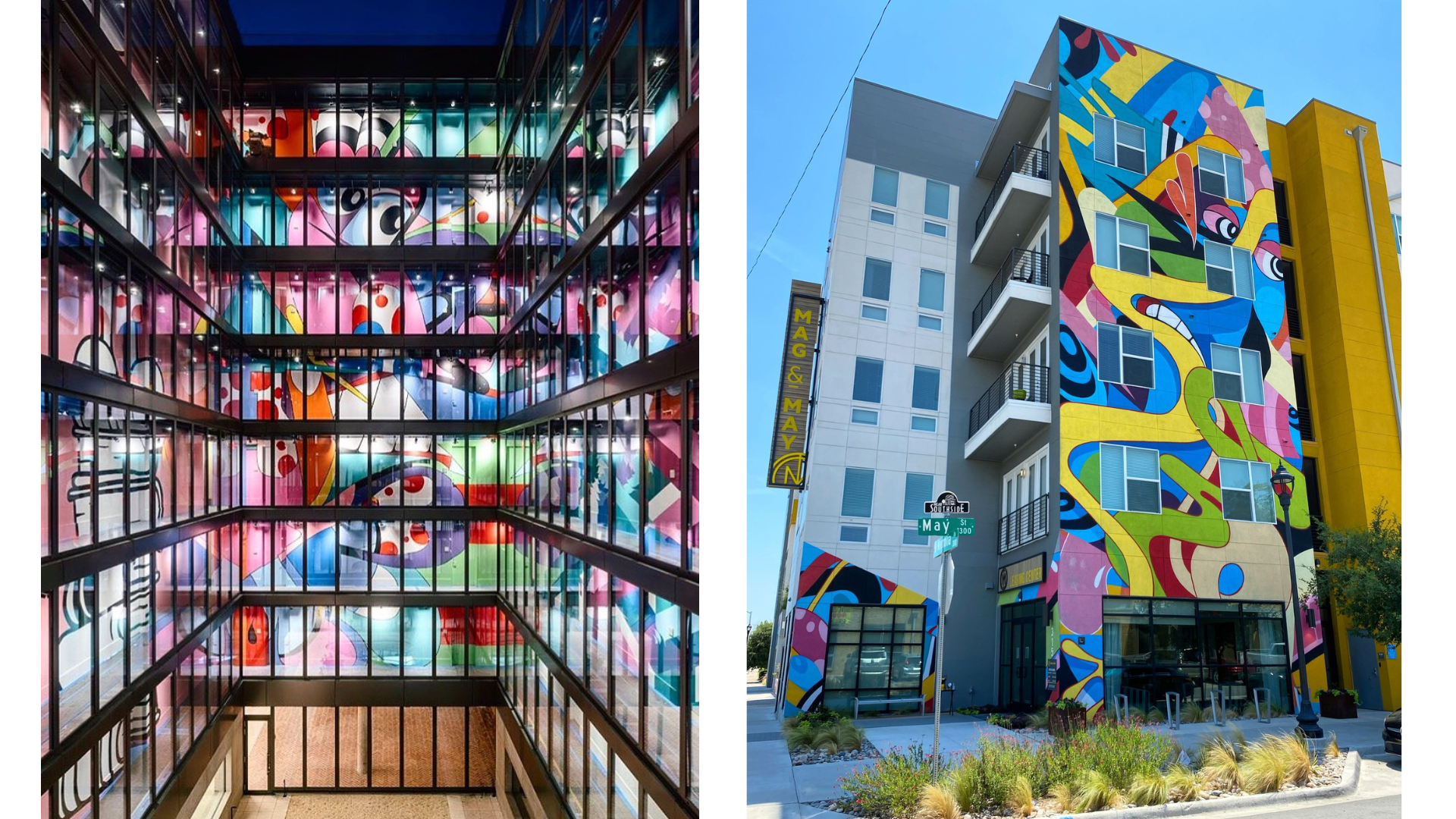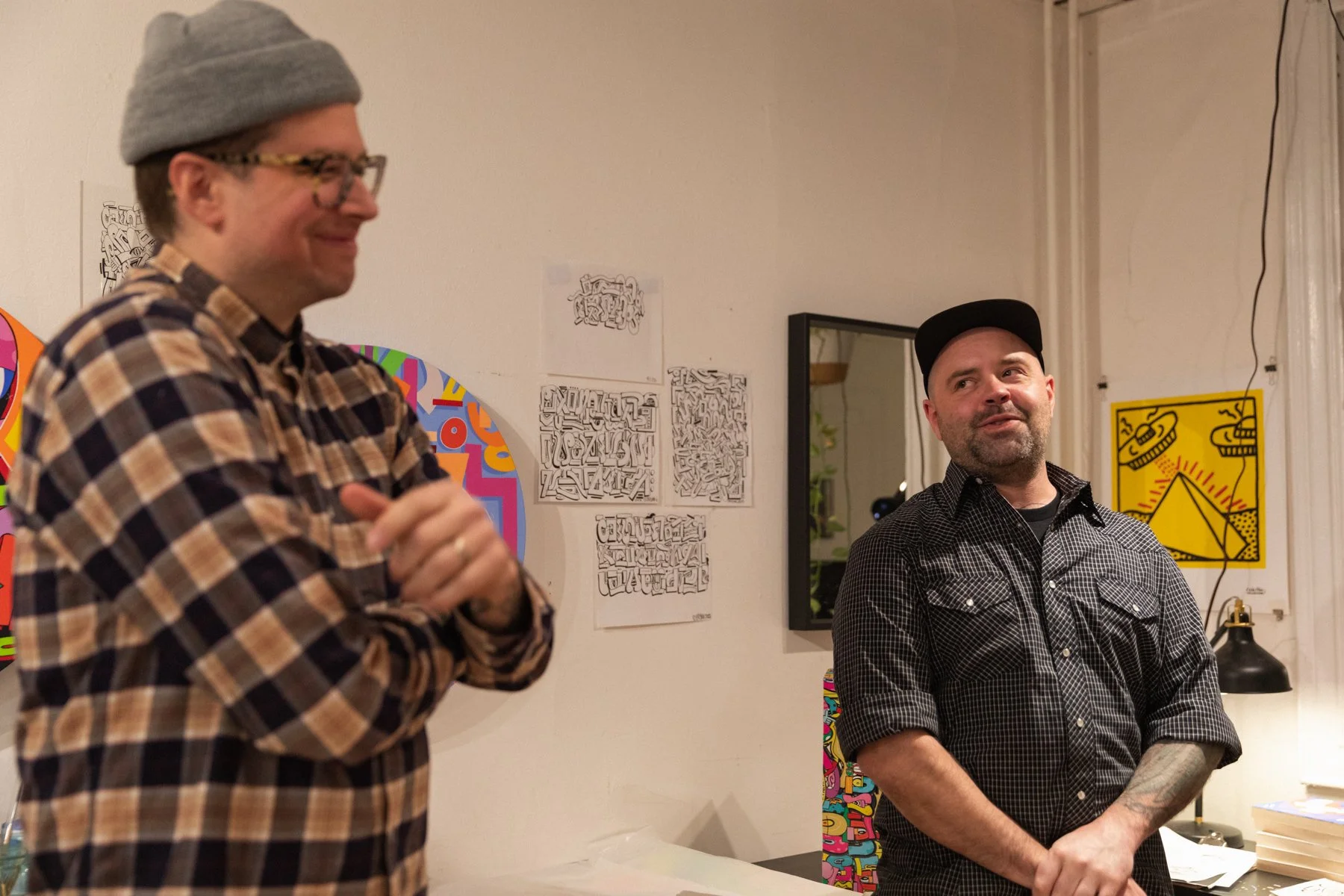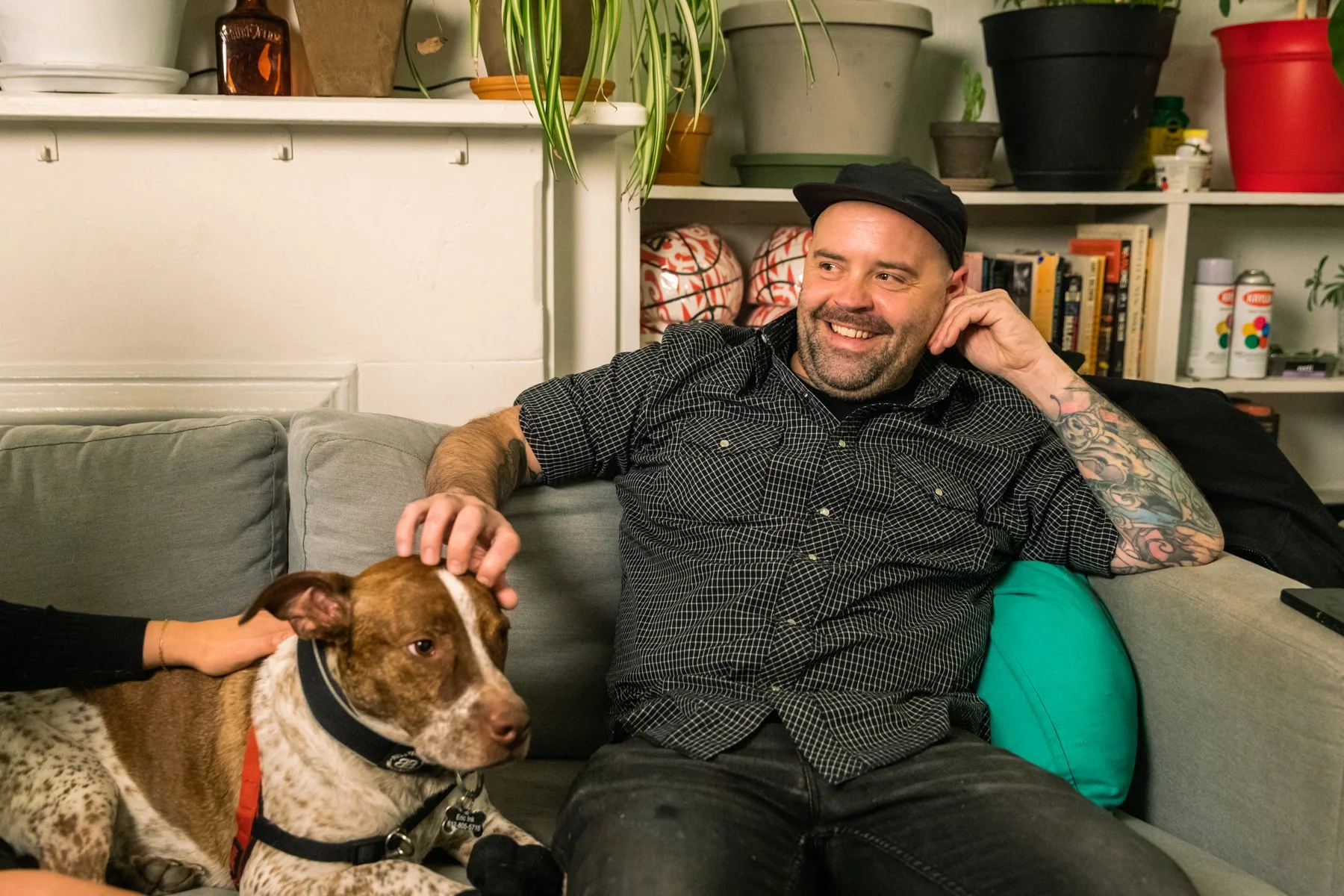Holiday Cheers with Eric Inkala
The holidays are a time to join together with friends, share joy, and wonder aloud: Did 2023 really happen, or did I imagine all that in my head? Fortunately, this whirlwind year was all real, including our dream-come-true of collaborating with friend to Colossal's creative director John Samels and star artist, Eric Inkala. In our holiday tradition of keeping spirits bright, our 2023 Colossal wine bottle donned a custom design by — you guessed it. We caught up with Eric in his home studio in Greenpoint to reflect on projects past, hopes ahead, and the creative connections that keep us moving forward.
Pictured (left to right): Katie Danforth, Eric Inkala, Milo the dog, John Samels.
Katie Danforth: Can you tell us a little bit about this wine bottle design? Obviously this is our first collaboration with you, which was very exciting for us.
Eric Inkala: It's probably four or five different drawings — I picked pieces that I liked and kind of collaged them together. Then I was like, I think I need to paint that. When I’m making a painting, I don't do a full color mock up. All my work is really spontaneous, but I like this design that much. [Picking up the holiday card] This looks rad too.
KD: It does, you did that.
EI: I mean, I didn't do the layout. [Laughs]
KD: Back to spontaneity — how do you usually plan for a new piece?
EI: The funny thing is, most people don't know that I'm colorblind. I don't think about it at all, because this is how I've always seen. If you really think about it, the reason I use so much contrast is because I'm colorblind. My color choices are partially from when I did graffiti, but also I use very bright colors.
John Samels: It's very bright and poppy to us. I'd love to see what it looks like to you. How old were you when you found out you were colorblind?
EI: When I was in middle school I took that colorblind test where it's all the dot patterns. And like, any normal seeing eye would see a 13 or whatever, but I look at it and there's nothing there.
KD: It is wild to hear just because your compositions are so driven by color — it's sort of like Beethoven composing deaf. It's hard to wrap my mind around how you create something that's so visually stimulating, but you're not experiencing it in that way.
EI: I don't know why I haven't gotten those colorblind glasses yet. If you look them up, you'll see all these videos of people crying when they see these colors for the first time. They look at the sky and see this vibrant color that they’ve never experienced before, in something that they’ve seen every day of their lives.
JS: I feel like you could do this. You gotta do a gallery show, but part of it is you walking in and seeing your work the first time.
EI: That's actually not a bad idea. I'm just walking through the gallery, just bawling, staring at my painting.
JS: Why haven't you bought those yet? Is this scary a little bit?
EI: A little bit, yeah. I think maybe I'm scared it’s going to change my paintings. I don't know if that would be a bad thing.
JS: We went to the same high school, different years. How did that arts program help you launch this style? Because you have a very unique, Eric Inkala style.
EI: Arts high school was a huge game changer. If I hadn’t found it and got in, I probably would have dropped out from regular school. I hated it. I started skateboarding, doing graffiti, then I found the program and begged my mom to let me apply. They were like, If this is what you want to do. They've always been huge supporters of what I do. I know every artist says it, but when I was a kid, I was always drawing. The biggest thing that really got me into anything more artistic was graffiti. Once I started doing that, I started drawing more and then that flipped the switch in my brain. When I went to arts high school, I was introduced to painting and sculpture and photography and all this different stuff — that's when I realized my love for painting. My teacher showed me a documentary on Philip Guston and I fell in love. Keith Herring was also a huge inspiration back then — and still is a huge inspiration. That's when I really started making paintings and realized that it could also be a career path.
JS: I was in my regular public high school and I took some art classes. I knew very quickly that I wanted to do some sort of image making, but I couldn't draw — that's not how it was happening for me. I got into photography and started making weird stuff in the dark room. I was working at a bagel shop and one of my co-workers had just graduated from [Perpich Arts High School] and she was like, You have to go to this school.
KD: What about graffiti appealed to you? It's obviously a very physical, adrenaline-fueled way to engage with art. There isn’t that kind of opportunity with other mediums.
EI: I wouldn't consider myself an adrenaline junkie, but the adrenaline from that…I don't think you can get that anywhere else. I did most of my graffiti in high school — I was doing trains, pieces, rooftops, tagging the whole city.
KD: What was the journey like from the Minneapolis graffiti scene, to becoming like a fine artist in New York City? Take me through the evolution.
EI: The first thing I did after moving here was get a studio, start painting, and meet people. I went to a lot of gallery openings, met a lot of artists here, started networking and getting introduced to galleries through other people. My old studio used to be a block away from the Bushwick Collective headquarters. I'd see this dude everyday — Joe, who runs it. One day I started talking to him about murals. I showed him my stuff and he was like, Oh shit, dude, these are dope. You want a wall?
JS: Oh, amazing.
EI: I wasn't really doing graffiti anymore, but I still loved using spray paint. It was kind of an unintentional jump into really large-scale mural work. I did that wall with him, and because there's so much crazy foot traffic and weird graffiti tours over there, I got a second project. Whoever ran the company saw my work on the street and contacted me to paint a three-story building further in Bushwick.
KD: When you're doing murals, is it always with spray paint?
EI: Yeah, usually. I just did a mural inside Google's new headquarters, so I couldn't use spray paint. Hand-painting it took way longer.
JS: We know all about that.
KD: Do you have a preferred mode of working? Are your favorite days spent painting here, or do you prefer traveling around and working outdoors?
EI: Honestly, the murals are the most fun. When you're sitting and doing a painting, you're just staring at the same thing and all your movements are tight (unless you're working really large). But when you're outside, you're using your whole range of motion.
KD: You seem to split your time evenly between public artwork, gallery shows, and client collaboration. Usually we see artists prioritize one mode of work rather than engage all of them. Is it overwhelming?
EI: No, it's super fun — each thing feeds the other. It's good to get outside the box and switch it up. With the brand stuff, that's a totally new direction altogether. I never considered myself a designer, but I started getting projects and I had to learn how to use Procreate. That learning curve was a little tough at first.
JS: It was a lot of coming over to my house to scan shit.
EI: [Laughs] I have a lot of graphic designer friends, and they probably hate me now. I was like, I know this is probably really easy for you, but….
JS: Remind me of some of the recent collabs you’ve done? With Bape, you did the shirt and sneaker…
EI: I did a sneaker with Coach. For Bape, I've done two separate projects. I’ve done some Casetify stuff recently.
KD: I know New Year’s resolutions are kind of lame, but zooming out: are there any intentions or hopes for yourself in 2024?
EI: I'm doing a solo show at a gallery in Philly. After that I'm doing a super massive show at a gallery in Texas that’s gonna be a lot of large-scale work, and I’m starting to get into sculptural work. It’s totally new for me. I told the gallery owner in Texas I wanted to do a few sculptures in the space but also outside of the gallery. She was like, Cool, amazing, I’ll figure it out. Zooming out, I'm just trying to keep moving forward. Bigger paintings, bigger walls.
This interview has been edited for brevity and clarity. We’d like to thank our friend Eric Inkala (@drinkala) for joining us and hosting this interview. To learn more about artist sourcing opportunities, email us at info@colossalmediagroup.com.

